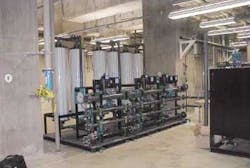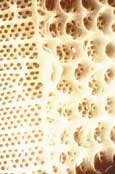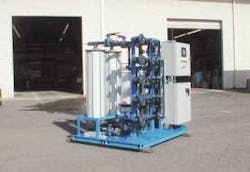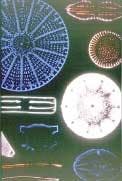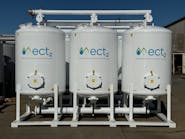By John H. Marsh
Diatomaceous Earth (DE or Diatomite) precoat filtration has been a widely used method of fluid purification for over 100 years. There are thousands of installations in the chemical, pharmaceutical, metals and food & beverage industries where critical separations are required.
Modular Skid, 0.55 MGD unit shown
In potable water production, DE filtration is a mechanical separation of solids and microorganisms from raw water. The first widespread use of DE for production of potable water was performed by the U.S. Army during World War II. Today there are over 200 plants in North America producing high quality drinking water at low cost using DE filtration technology. Extensive pilot testing at the University of NSW, Australia, demonstrated 6-log reduction of cryptosporidium oocysts, documented in the December 1997 and 2001 issues of the AWWA Journal.
Even though DE is one of the four methods originally listed by the USEPA for removal of chlorine-resistant pathogens, many professionals and regulators in the municipal field are not fully aware of the capabilities of this proven and efficient technology. Considering that virtually all other beverages have some form of DE filtration in their production processes, it is evident DE has been largely overlooked for potable water. Smaller communities with limited resources are becoming more aware of the need to filter their surface water sources at reasonable cost, and DE filtration could well be an attractive treatment selection.
What is Diatomite?
Diatomaceous Earth is the fossilized skeletal remains of single celled aquatic plants called diatoms. These microscopic organisms such as plankton or algae have the unique ability to extract silica from water to produce a microporous exoskeleton. When the life cycle is completed, the organic matter decomposes and the skeletal remains accumulate to form an inorganic sedimentary deposit.
Diatomite is a unique mineral due to its low density, high porosity and relative inertness, making it an ideal filtering medium. Diatoms range in size from less than 5 to over 100 microns, and are characterized by species-specific morphology with interior pores as small as 0.1 micron.
There are a number of commercial deposits worldwide with several major sites in western U.S. where filtration grade product is abundant. Examples pictured show freshwater species of cylindrical form and marine species in a variety of shapes.
How Diatomite is Processed
The production of diatomite filter aids is a specialized operation requiring large processing facilities backed by heavy earth-moving equipment. The two major North American suppliers are EaglePicher and Celite. EaglePicher has produced freshwater DE products in Nevada since 1946. Celite produces marine and freshwater DE in multiple locations worldwide and has produced DE products for 100 years. Both firms process and market a range of highly refined products that meet NSF Standard 61 certification for filter aids.
Photo Copyrighted by World Minerals Inc. — Reprinted by Permission
Processing steps include drying, milling, classification and calcining. Product destined for the water treatment market are further purified and classified to produce a tightly controlled porosity and permeability to assure specific and consistent performance.
The finer grades are comprised of natural DE, so varying degrees of calcination are required to produce grades with larger median pore sizes, with each grade having a wide particle size distribution to create the cake formation capability necessary in filtration applications.
Both firms market many grades specific to various non-potable water applications such as food, beverage and pharmaceuticals. Medium to coarse grades are typically used for potable water filtration. Physical properties of EaglePicher and Celite standard grades are available on their websites; www.eaglepicher.com and www.worldminerals.com.
DE Filter Types
There are a wide variety of precoat filter processes but all share the same basic cycles known as: 1) precoating; 2) service with bodyfeed; 3) backwash or cleaning. The process involves each of these functions whether the filter system is a pressure or vacuum type. The major difference is how the regeneration cycle (backwash, precoat & return-to-service) is managed.
Pressure DE filters offer the option of manual vs automated valving and are available in a wide variety of configurations. The mode of operation is based on a number of source specific conditions such as the need for the plant to respond or regenerate on an unattended basis and system automation can be tailored to operator expertise.
Photo Copyrighted by World Minerals Inc. — Reprinted by Permission
Vacuum filters can be automated but are typically cleaned and put back into service manually so are generally considered for larger facilities where operations are staffed full-time. Regardless of type and automation capability, DE filters require only a level 2 operator certification as determined by the Associations of Boards of Certification (ABC).
The first and essential step in the precoat cycle is to establish a uniform and stable cake where DE in slurry form is recycled through permanent elements (septums) back to the clean tank. Precoat volume is a function of hydraulic design and can vary from 0.1 to 0.2-lb./sq ft. of filter area. When purity is confirmed, service flow commences.
At this point, a continuously metered amount of DE called bodyfeed is introduced into the raw water throughout the service cycle. This assures protection of the precoat layer while keeping the cake channels open as contaminants are trapped. When properly proportioned, optimum efficiency is achieved whereby run times can be increased by 2 to 4 times under most conditions.
The service cycle is terminated when a predetermined maximum pressure loss across the filter is reached (terminal delta-P). At this point, the system is put into a backwash or cleaning cycle.
Note that varying flowrates are involved in each of the regeneration cycles so a VFD controlled pump is recommended. Also, a constant service flowrate is desirable for all filters (1.0 USGPM/sq ft is standard for potable water), partly to monitor pressure loss, which initiates a regeneration cycle. Terminal delta-P of 20-25 psid is common for pressure types while vacuum filters are limited to approximately 10 psid. Regeneration can take 5-30 minutes for pressure filters to an hour or more for manual cleaning methods required for vacuum filters.
In short, when a uniform and stable media cake is established, all DE filters will provide membrane level efficiency with low capital and O&M costs.
Benefits of DE Filtration
As a universally approved method under the Surface Water Treatment Rule (SWTR), plant operators can be confident their system will produce a high quality effluent and meet current and foreseeable mandates for water quality using DE precoat technology. Recent versions of the SWTR have tightened effluent quality requirements for conventional and direct filtration plants to produce 0.3 NTU while maintaining the same 1 NTU benchmark for DE. Diatomite filtration equals or exceeds efficiency of MF systems without the attendant cost or liability.
Additional benefits include:
* Low capital/installation costs.
* O&M costs 8 to 12 cents/1000 gal. Based on system size.
* Small footprint, all tankage and support equipment on-board.
* Can be fully automated for unattended operation.
* Eliminates alternate technology testing protocols where required.
* Reduces solid organic content.
* Water chemistry eliminated, Level 2 operator certification.
* Filtrate/BW ratio >99.9% common.
About the Author
John H. Marsh has been sales manager and a principal of Blace Filtronics, Inc., since 1993. The company is a manufacturer of integrated DE filtration plants for industrial and potable water applications. Prior to joining Blace, he was involved a sales engineer and subsequently a manufacturers representative specializing in instrumentation and a wide range of purification products including micro-filtration, membranes and ion exchange to power, process and semiconductor plants in the NW. As co-founder (1971) of Set-Point Control, he was active in ISA, becoming Portland Section president in 1984/85. Marsh has been a member of AWWA since 1993. You can contact Blace at 360-750-7709 or by e-mail at "[email protected]"
